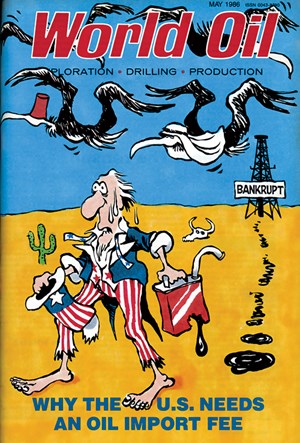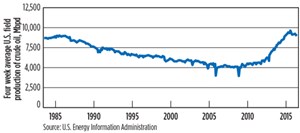Boom to bust: The fight for an import fee
The face of the oil and gas industry has changed markedly since the 1980s and 1990s, but two themes remain remarkably consistent—boom and bust.
Faced with declining demand and surging production from non-member nations, OPEC and its de facto leader, Saudi Arabia, sought to defend oil prices by curbing production in the first half of the 1980s. Saudi Arabia, the then-swing producer, bore the brunt of the cuts, as the Persian Gulf nation went from producing about 10 MMbopd at the start of the decade to an average 3.4 MMbopd in 1985.
However, the Saudis abandoned this approach toward the end of 1985 by opening the spigots and moving to increase market share. The Kingdom also implemented a netback-pricing concept, which tied crude prices to the value of the refined products. This new pricing structure guaranteed specific margins to refiners and shifted the risk from the oil purchaser to the producer.
Other OPEC nations followed suit, which led to a supply glut and the sharp contraction of oil prices in early 1986. According to the U.S. Energy Information Administration, in July 1986, the average FOB price for OPEC crude had dropped to $9.85/bbl from $23.29/bbl the previous December. The move was to have far-reaching implications for the upstream industry, particularly in the U.S.
While U.S. crude production trended up for the first half of the decade (rising from 8.597 MMbopd in 1980 to 8.971 MMbopd in 1985), Saudi Arabia’s decision to flood the market forced U.S. production onto a downward trajectory for the remainder of the decade, as operators were forced to scrap projects and shut in wells, Fig. 1. In fact, domestic production closed out the era, after a second bust, at just 5.822 MMbopd in 2000—a contraction of almost 33% from the 8.680 MMbopd recorded for 1986.
Writing at the start of 1986, World Oil took scope of the market in the first issue of the year. To quote from World Oil’s January 1986 issue, “OPEC’s abandonment last month of production curbs to prop up oil prices is an effort to transfer the burden of price stability to such non-OPEC producers as Britain, Norway, the Soviet Union and Mexico. Saudi Arabian oil minister Ahmed Zaki Yamani said the tactic is aimed at grabbing a ‘fair share’ of world oil sales.” Fast forward to the prevailing crisis, which has now been consuming the upstream industry for the better part of two years, and we see a similar situation.
Then, as now, the price crash had far-ranging consequences, particularity in the U.S., which had some of the highest production costs in the world. The price crash prompted one of the sharpest contractions in the history of the oil industry. Then, as now, hundreds of thousands of workers, whose livelihoods were, to one extent or another, dependent on oil, lost their jobs; rigs were stacked in unprecedented numbers; companies slashed their budgets to the bone; and high cost/high risk projects were deferred for a better, more profitable, day.

So severe was the crisis, that in May 1986, World Oil’s editorial staff took the somewhat unusual move of sticking its “collective neck out in favor of import fees on crude oil and refined products.” In that month’s issue, which may boast one of the magazine’s more memorable covers, the editorial team went on record in a bid to “urge industry” to present a united front on the subject, saying that no group—or nation—should be exempted from the fee, Fig. 2.
“The future security and economic health of the country are being placed at great risk, because of Saudi Arabia’s current manipulation of world crude prices,” the editors said. Such manipulation, the editors warned, was damaging U.S. productive capacity; drilling and production infrastructure; and placing the U.S. energy future in the hands of foreign nations.
While the 16-page special report acknowledged that there “are many still against the idea,” the editorial supplement set out to help people appreciate the need for the fee. The report also included a tear-out petition, which readers were encouraged to complete and circulate among their friends and co-workers.
The spirit of the campaign was perhaps best summed up by then-Editor Thomas R. Wright, Jr.’s closing statement in the introduction to the supplement. Mr. Wright said, “The future of the country, the industry and hundreds of thousands of jobs, both in this industry as well as many others, depends on how much noise we all make in Washington. Let’s make a hell of a lot of it, and the sooner the better.”
Writing in Roundup, GPC’s then in-house publication, Chairman William G. Dudley urged all employees to get behind the initiative, asking employees to “explain to your neighbors the seriousness of the situation and the impact on their own jobs and futures as residents of Texas. Sit down tonight and write your Congressmen and Senators, urging their attention to the problem—and get your neighbors to do the same.”
Readers apparently identified with the magazine’s editorial stance, with Editorial Director Bob Scott reporting in June that “virtually 98% of readers’ letters and calls agree with us on this crucial national need.”
World Oil’s report even drew applause from then-U.S. Senator Lloyd Bentsen (D–Texas), who sent in a letter saying, “Thank you for sending the special report from World Oil of May 1986. Clearly, we’re in agreement on the problem, and the best way to solve it: an oil import fee. We have a lot of others to convince, and your reprint gives us ammunition we need to bring more people in Washington over to the side of the angels.”
That praise prompted an eye-catching editorial response in the magazine: “Senator, we appreciate your words, but this is absolutely the first time anybody ever classified us at so high a level. We’re more used to being told to go to the lower, hotter regions—especially by some of your colleagues from Texas.”
Ultimately, an oil import fee was not introduced, and the domestic U.S. industry was left to bear the brunt of the price war. Sadly, the price of oil was a source of yet more pain toward the end of this time period. The price of oil fell once again in 1998, before rising the following year.
According to a report in the May 2000 issue of World Oil, the 1998 price collapse led to thousands of qualified workers leaving the oil patch for good. According to data from the Bureau of Labor Statistics, cited in that issue, the E&P industry in the U.S. had lost 26% of its workers over the past decade. The worst one-year drop was in 1999, when payrolls fell to 293,100 workers—a 14% drop from the 339,200 in 1998. That shortage was attested to by then-editor Robert E. Snyder in one of his columns. Writing in August 2000, Snyder cited, as an example, a case where a tool pusher had been rigged up for 10 days without a crew “before he went looking on a competitor’s nearby rig, where he got a better offer and took it.”
Despite the substantial time gap, the upstream industry—particularly in North America—is essentially struggling with the same problem—overproduction—that has periodically sent prices plunging throughout the industry’s short history. As the old bumper stickers used to say, “Please God, Just Give Me One More Oil Boom.” ![]()



